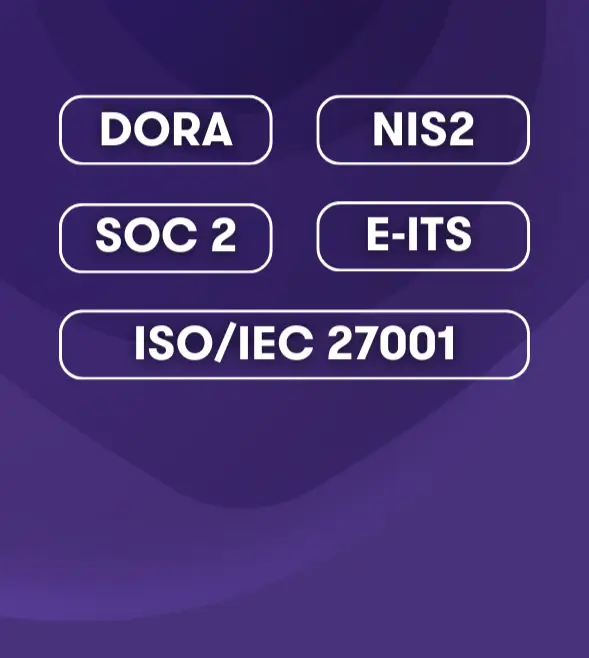-
Other audit services
We help clients with the application and use of foreign financial aid of EU and other funds and help prepare financial reports.
-
Audit calculator
The calculator will answer if the company's sales revenue, assets or number of employees exceed the limit of an inspection or audit.
-
Payroll and related services
We perform payroll accounting for companies whether they employ a few or hundreds of employees.
-
Tax accounting
Grant Thornton Baltic's experienced tax specialists support accountants and offer reasonable and practical solutions.
-
Reporting
We prepare annual reports in a timely manner. We help to prepare management reports and various mandatory reports.
-
Consolidation of financial statements
Our experienced accountants and advisors help you prepare consolidation tables and make the consolidation process more efficient.
-
Consultancy and temporary staff
Our experienced specialists advise on more complex accounting transactions, rectify poor historic accounting, and offer the temporary replacement of an accountant.
-
Outsourced CFO service
Our CFO service is suitable for companies of all sizes and in all industries. We offer services to our clients in the required amount and competences.
-
Assessment of accounting processes
We help companies to implement accounting practices that are in compliance with local and international standards.
-
Accounting services for small businesses
We offer affordable service for small businesses. We help organize processes as smartly and cost-effectively as possible.
-
Cryptocurrency accounting
We keep up with blockchain technology to serve and advise crypto companies. We are supported by a network of colleagues in 130 countries.
-
Trainings and seminars
Our accountants have experience in all matters related to accounting and reporting. We offer our clients professional training according to their needs.

-
Business advisory
We offer legal support to both start-ups and expanding companies, making sure that all legal steps are well thought out in detail.
-
Fintech advisory
Our specialists advise payment institutions, virtual currency service providers and financial institutions.
-
Corporate advisory
We advise on legal, tax and financial matters necessary for better management of the company's legal or organizational structure.
-
Transaction advisory
We provide advice in all aspects of the transaction process.
-
Legal due diligence
We thoroughly analyze the internal documents, legal relations, and business compliance of the company to be merged or acquired.
-
In-house lawyer service
The service is intended for entrepreneurs who are looking for a reliable partner to solve the company's day-to-day legal issues.
-
The contact person service
We offer a contact person service to Estonian companies with a board located abroad.
-
Training
We organize both public trainings and tailor made trainings ordered by clients on current legal and tax issues.
-
Whistleblower channel
At Grant Thornton Baltic, we believe that a well-designed and effective reporting channel is an efficient way of achieving trustworthiness.

-
Business model or strategy renewal
In order to be successful, every company, regardless of the size of the organization, must have a clear strategy, ie know where the whole team is heading.
-
Marketing and brand strategy; creation and updating of the client management system
We support you in updating your marketing and brand strategy and customer management system, so that you can adapt in this time of rapid changes.
-
Coaching and development support
A good organizational culture is like a trump card for a company. We guide you how to collect trump cards!
-
Digital services
Today, the question is not whether to digitize, but how to do it. We help you develop and implement smart digital solutions.
-
Sales organisation development
Our mission is to improve our customers' business results by choosing the right focuses and providing a clear and systematic path to a solution.
-
Business plan development
A good business plan is a guide and management tool for an entrepreneur, a source of information for financial institutions and potential investors to make financial decisions.
-
Due diligence
We perform due diligence so that investors can get a thorough overview of the company before the planned purchase transaction.
-
Mergers and acquisitions
We provide advice in all aspects of the transaction process.
-
Valuation services
We estimate the company's market value, asset value and other asset groups based on internationally accepted methodology.
-
Forensic expert services
Our experienced, nationally recognized forensic experts provide assessments in the economic and financial field.
-
Business plans and financial forecasts
The lack of planning and control of cash resources is the reason often given for the failure of many businesses. We help you prepare proper forecasts to reduce business risks.
-
Outsourced CFO service
Our CFO service is suitable for companies of all sizes and in all industries. We offer services to our clients in the required amount and competences.
-
Reorganization
Our experienced reorganizers offer ways to overcome the company's economic difficulties and restore liquidity in order to manage sustainably in the future.
-
Restructuring and reorganisation
We offer individual complete solutions for reorganizing the structure of companies.
-
Corporate taxation
We advise on all matters related to corporate taxation.
-
Value added tax and other indirect taxes
We have extensive knowledge in the field of VAT, excise duties and customs, both on the national and international level.
-
International taxation
We advise on foreign tax systems and international tax regulations, including the requirements of cross-border reporting.
-
Transfer pricing
We help plan and document all aspects of a company's transfer pricing strategy.
-
Taxation of transactions
We plan the tax consequences of a company's acquisition, transfer, refinancing, restructuring, and listing of bonds or shares.
-
Taxation of employees in cross-border operations
An employee of an Estonian company abroad and an employee of a foreign company in Estonia - we advise on tax rules.
-
Tax risk audit
We perform a risk audit that helps diagnose and limit tax risks and optimize tax obligations.
-
Representing the client in Tax Board
We prevent tax problems and ensure smooth communication with the Tax and Customs Board.
-
Taxation of private individuals
We advise individuals on personal income taxation issues and, represent the client in communication with the Tax and Customs Board.
-
Pan-Baltic tax system comparison
Our tax specialists have prepared a comparison of the tax systems of the Baltic countries regarding the taxation of companies and individuals.
-
Internal audit
We assist you in performing the internal audit function, performing internal audits and advisory work, evaluating governance, and conducting training.
-
Internal Audit in the Financial Services Sector
We provide internal audit services to financial sector companies. We can support the creation of an internal audit function already when applying for a sectoral activity license.
-
Audit of projects
We conduct audits of projects that have received European Union funds, state aid, foreign aid, or other grants.
-
Prevention of money laundering
We help to prepare a money laundering risk assessment and efficient anti-money laundering procedures, conduct internal audits and training.
-
Risk assessment and risk management
We advise you on conducting a risk assessment and setting up a risk management system.
-
Custom tasks
At the request of the client, we perform audits, inspections and analyzes with a specific purpose and scope.
-
External Quality Assessment of the Internal Audit Activity
We conduct an external evaluation of the quality of the internal audit or provide independent assurance on the self-assessment.
-
Whistleblowing and reporting misconduct
We can help build the whistleblowing system, from implementation, internal repairs and staff training to the creation of a reporting channel and case management.
-
Information security management
We provide you with an information security management service that will optimise resources, give you an overview of the security situation and ensure compliance with the legislation and standards.
-
Information security roadmap
We analyse your organisation to understand which standards or regulations apply to your activities, identify any gaps and make proposals to fix them.
-
Internal audit of information security
Our specialists help detect and correct information security deficiencies by verifying an organization's compliance with legislation and standards.
-
Third party management
Our specialists help reduce the risks associated with using services provided by third parties.
-
Information security training
We offer various training and awareness building programmes to ensure that all parties are well aware of the information security requirements, their responsibilities when choosing a service provider and their potential risks.
-
Digital Operational Resilience Act (DORA)
We will help you create a DORA implementation model that meets your company's needs and ensures that you meet the January 2025 deadline.

-
ESG advisory
We help solve issues related to the environment, social capital, employees, business model and good management practices.
-
ESG audit
Our auditors review and certify sustainability reports in line with international standards.
-
Sustainable investments
We help investors conduct analysis of companies they’re interested in, examining environmental topics, corporate social responsibility and good governance practices.
-
Sustainable tax behaviour
Our international taxation specialists define the concept of sustainable tax behaviour and offer services for sustainable tax practices.
-
ESG manager service
Your company doesn’t necessarily need an in-house ESG manager. This role can also be outsourced as a service.

-
Recruitment services – personnel search
We help fill positions in your company with competent and dedicated employees who help realize the company's strategic goals.
-
Recruitment support services
Support services help to determine whether the candidates match the company's expectations. The most used support services are candidate testing and evaluation.
-
Implementation of human resource management processes
We either assume a full control of the launch of processes related to HR management, or we are a supportive advisory partner for the HR manager.
-
Audit of HR management processes
We map the HR management processes and provide an overview of how to assess the health of the organization from the HR management perspective.
-
HR Documentation and Operating Model Advisory Services work
We support companies in setting up HR documentation and operational processes with a necessary quality.
-
Employee Surveys
We help to carry out goal-oriented and high-quality employee surveys. We analyse the results, make reports, and draw conclusions.
-
HR Management outsourcing
We offer both temporary and permanent/long-term HR manager services to companies.

-
Digital strategy
We help assess the digital maturity of your organization, create a strategy that matches your needs and capabilities, and develop key metrics.
-
Intelligent automation
We aid you in determining your business’ needs and opportunities, as well as model the business processes to provide the best user experience and efficiency.
-
Business Intelligence
Our team of experienced business analysts will help you get a grip on your data by mapping and structuring all the data available.
-
Cybersecurity
A proactive cyber strategy delivers you peace of mind, allowing you to focus on realising your company’s growth potential.
-
Innovation as a Service
On average, one in four projects fails and one in two needs changes. We help manage the innovation of your company's digital solutions!

After the year of the coronavirus, there is good reason to review the value of a company’s assets with particular care. Even more, because the value of some assets may instead have increased in these muddled times, as we heard on the Äripäev Radio programme ‘Kasvukursil’, on which Mart Nõmper, Sworn Auditor and Head of Audit and Assurance Services, and Mikk Mägi, Head of Financial Advisory at the pan-Baltic audit, outsourcing and advisory services provider Grant Thornton Baltic, discussed asset valuation.
It is very timely to discuss the valuation of company’s assets, as 31 December was the balance sheet date for many companies, and management must conduct various assessments of both assets and liabilities. “What is important today is that we have left behind the extraordinary year of 2020 in which the value of many assets fell, while the value of others rose. “Money-printing” has been very robust and not everything has become cheaper – instead, the prices of some assets have risen without doing anything,” Nõmper explains.
Besides asset valuation, Nõmper reckons it is worth critically reviewing accounting principles, as due to changes in the environment the principles in use today may not provide a fair overview of the net assets and performance of companies. For an accountant, debit and credit have indeed remained the same, but asset valuation is a great challenge for management in this new situation. Mägi adds that management should conduct the asset valuation in cooperation with accountants, as this could be a new subject for both parties this year.
What has risen in value and what has fallen in value this past year?
Real estate prices, which at first were predicted to drop, are one of the factors that have increased value. Though equity markets rapidly deteriorated, the average indexes of short-term financial investments are also currently higher than a year ago. The impairment of assets is individual and specific, depending on the industry the company is active in. I am certain everyone has heard of difficulties in the tourism sector, which means that related assets may show signs of impairment. Some companies have closed down production units, which has caused the need to recognize an impairment loss on those particular assets.
In any case, experts say that it is important to check the value of assets on the balance sheet for potential impairment. There are several indications that an asset may be impaired: when market interest rates have considerably increased, the general economic environment has deteriorated, discount rates have increased, certain business units are being closed, business plans have not been successful or the net assets of a company do not meet the requirements of the Commercial Code, etc.
“When we talk about the valuation of a company, we should recall the old saying that beauty is in the eye of the beholder. This means that for the parties, i.e. the buyer and the seller, the value of a company may be different depending on the particular situation and on which side you stand on,” Mägi says. “The principle valuation approaches are cost approach, income approach and market approach. Each has its own specifics and includes different, detailed methods of application.”
The most simplified approach is finding the fair value of net assets, where both the company’s assets and liabilities are to be valued at fair value. For the owner, the fair value is the difference between the assets and liabilities. A simple example: if the fair value of the assets of a company is 1,000 euros and it has liabilities worth 900 euros, the fair value of the owner’s equity of that company is 100 euros. Furthermore, we are dealing with different assets which the company may keep on its balance sheet, such as receivables, inventories and tangible assets, which are often not recognised at fair value. “In such an event, we have to evaluate all of these assets and it may be necessary to write down some receivables and inventories. Or on the contrary, if the fair value of tangible assets is actually higher than the carrying amount of the assets, then we have to take this into account. In essence, this is still a simplified approach which might not take into account the company’s future potential, but it is nevertheless handy to use in the case of asset management companies or companies that are discontinuing their activities,” Mägi explains.
With regard to market approaches, we can talk about various valuation multiples like earnings multiples, revenue multiples, book value multiples etc. This approach assumes the presence of a good reference base of comparable publicly traded companies or reliable information on recent transactions. In Estonia, there might be few comparable publicly traded companies and the transparency about comparable deals is low, which is why companies often move on to the income approach, which typically means using the discounted cash flow method. When using the income approach, the value of a company that is found is based on two factors: the forecasted future cash flow to be generated by the company and the probability of achieving the forecasts. It is important to highlight that the owners bear the highest risk here, as the income will first of all go towards paying the suppliers, the employees and the state, and after debt to financing parties has been repaid, the remaining cash flow is for the owners. Mägi says that there are various aspects where people tend to make mistakes and with potential for error, e.g. which forecasts are appropriate, which discount rate should be used, etc.
“In choosing the valuation approach, the most important thing is to look at the particular company or asset. If its cash flow potential or return is low and there are indications that the value may be higher when assessed using the cost approach, then using the income approach may not be appropriate. A rational investor would say that if the value decreases over time it would therefore be more reasonable to discontinue the activities of the company. Choosing the approach depends on what kind of a company it is, where does it operate and what information is available to us. If there are no comparable companies, other methods than the market approach should be considered. Combining different approaches is also an option. Real estate management companies that own and manage certain objects are generally assessed using the net asset method, while the fair value of the real estate investments in the balance sheet is often found using the income approach. For Estonian small and medium sized companies, the most commonly used method is the income approach.”
Value in use and fair value
In asset valuation, the terms ‘fair value’ and ‘value in use’ also come into play. Value in use comes into play in impairment testing of assets on the balance sheet date if there are indications of impairment. An impairment test is performed to determine the recoverable amount of an assets which is higher of the fair value of an asset (less costs to sell) or its value in use. In the case of the former, it is basically presumed that the carrying amount of the asset will be covered by a sales transaction. However, in the case of the value in use it is presumed that the carrying amount of the asset will be covered by the continued use of the asset. One of the differences between the value in use and the fair value is that the cash flows used in calculating the value in use shall not include cash flows (both income and expenses) from additional investments for the improvement of the asset. For example, if a hotel is planning a large-scale improvement in the future periods as a result of which the 2-star hotel becomes a 3-star hotel, such investments and additional cash flow will not be taken into account when finding the value in use. However, they might be considered in assessing the fair value of the assets when using the income approach.
Nõmper states that there is no need to fear impairment losses, because when the general economic situation improves and the temporary crisis is over, the these impairment losses can be reversed. Only the impairment loss of goodwill cannot be reversed. “In general, the Estonian financial reporting standard has been very cost centred, although there have been developments in the past – for example, the recognition of real estate and financial investments and biological assets is allowed at fair value. At the same time, attitudes are more conservative to the extent in which tangible assets can be recognised at fair value.”
Many companies are therefore planning to make a transition to the International Financial Reporting Standards (IFRS), which is centred more on fair value and allows recognizing gains from the changes in value not allowed by Estonian laws. In the case of tangible assets, for example, the gains and losses arising from the changes of the fair value of the asset is allowed in certain cases. However, companies should thoroughly contemplate the decision to transition to the IFRS and consult with their advisors, as it requires a lot of recalculation, historical figures also need to be recalculated and the opening balances adjusted. In addition, the volume of information disclosed in the annual report and its notes will afterwards be considerably greater, and the introduction of the IFRS will make the activities of the company more transparent, which may not necessarily suit everyone.
“Besides that, for some years now we have been allowed to use different reporting forms, such as reporting forms for micro undertakings, SMEs and large enterprises, and many companies use the form for micro entity, which is the simplest one. However, the Estonian financial reporting standard does not allow the recognition of any asset at fair value in the case of the form for micro entity. We can say that the curtailing of annual reports will cost those who would like to show the fair value – they first have to adopt the form for small entity and can only then recognise, say, their real estate investments at fair value,” Nõmper explains. Or, the more fair value is used, the more information must be disclosed in the annual reports.
Common mistakes made in valuations
The first mistake can already occur in choosing the correct approach, because the choice of using the cost, market or income approach has to be justified. With regard to mistakes, Nõmper and Mägi say it is worth highlighting the mistakes that are commonly made when using the income approach, where the value is based on cash flow forecasts. “It requires considerable attention and time to ensure that there are no contradictions between, say, the results of the industry the company is active in, historical results and general economic environment forecasts. Information on the economic trends from analytics should be taken into account, may it be from the Ministry of Finance or the Bank of Estonia,” they explain. “We often see that everyone wants to draw a hockey-stick shaped growth curve on the revenue side, but the cost do not follow or they are not logically linked. It is also quite frequent that the changes in working capital are recognised as zero, but with a hockey-stick growth in revenue much of the cash can be tied up in additional working capital.”
This is also related to the issues presented with the coronavirus, as lockdowns entail various trends that companies should learn to foresee: certain clients may delay their payments and larger stock balances are held in order to cope with the uncertainties in the transport sector. Also, finding an appropriate discount rate in the case of the discounted cash flow method is a science in itself. The main thing to consider is that the forecasts need to be justified and rational.
A common mistake the experts see with regard to audits is the double counting of risks in valuations, with a negative scenario being included already in the forecasts taking into account the coronavirus situation, and even more negativity is added with a COVID specific risk premium to the discount rate. This could result in an extremely low valuation, which is not correct. The over-depreciating of tangible assets is also common – a typical Estonian company depreciates its tangible assets to zero and doing so over a rather short period of time. However, auditors can see that although the value of an asset is zero, the machinery operates perfectly well in production, generating cash flows for the company and earning a positive cash flow also upon the final sale of the asset.
In Nõmper and Mägi’s opinion, Estonian companies do not make such mistakes maliciously – they are just not aware that they need to pay attention to such details. “The workload of management is very high and the provision of management estimates is often underestimated. In reality, however, all major decisions can be read from annual reports. As the state of emergency continues, no one knows where it will lead to and is able to compile exact forecast of cash flows, it is sensible to draw up multiple cash flow scenarios, describe what influences the different versions, derive a weighted average cash flow based on probabilities and apply a market-based discount rate.”
If the financial reporting is at a good level within a company and it looks at the performance and forecasts on a monthly basis, then doing impairment testing for asset valuation purposes will not be a problem. And it is quite normal to experience some difficulties or obstacles in asset valuation – asking for help is a sign of strength! No one is an expert in every field. Engaging with experts mitigates risks and several heads put together will quite probably achieve the best results!








